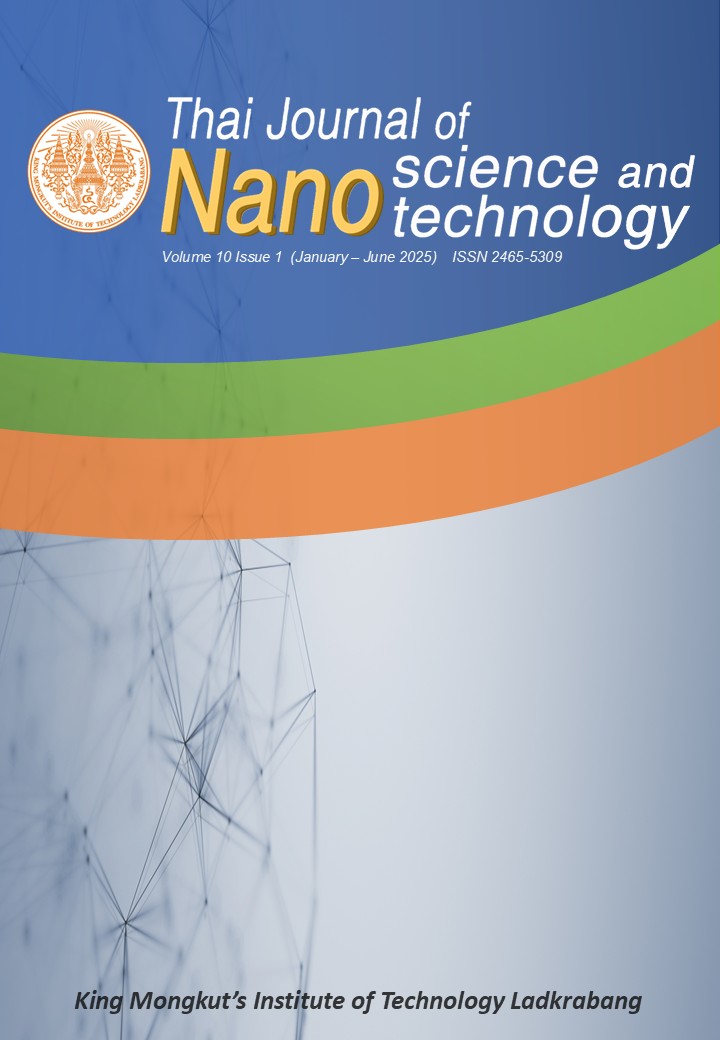Tuning Electrical and Optical Properties of SnO2 Films: Influence of Sb Dopant Concentration and Coating Layer in Spin-Coating Process
Main Article Content
Abstract
This study investigates the optical and electrical properties of antimony (Sb)-doped tin oxide (SnO2), commonly referred to as ATO, transparent conducting thin films synthesized via a wet chemical route. The films were fabricated using a sol-gel method combined with spin-coating. The effects of Sb doping concentrations (1, 3, and 5 mol%) and the number of coating layers (5 and 10) on the films' properties were systematically examined. ATO films were deposited onto glass substrates at a constant spin speed of 2000 rpm, followed by calcination at 600 °C for 2 hours. X-ray diffraction (XRD) analysis confirmed the formation of a tetragonal SnO2structure with no secondary phases. Optical measurements revealed high transparency in the visible range, with transmittance values between 60% and 80%. The lowest resistivity of 0.16 Ω·m was achieved with 5 mol% Sb and 10 coating layers, which also corresponded to the highest carrier concentration of 2 × 109 cm-3, as determined by Hall effect measurements. These results demonstrate that optimized ATO films possess desirable properties for electronic and optoelectronic device applications.
Article Details

This work is licensed under a Creative Commons Attribution-NonCommercial-NoDerivatives 4.0 International License.
References
Exarhos, G.J., Zhou, X. (2007) Discovery-based design of transparent conducting oxide films. Thin Solid Films, 515(18), 7025-7052. https://doi.org/10.1016/j.tsf.2007.03.014
Hammad, T.M., Hejazy, N.K. (2012) Retracted: Structural, electrical, and optical properties of ATO thin films fabricated by dip coating method. International Nano Letters, 2, 7. https://doi.org/10.1186/2228-5326-2-7
Hossain, F., Shah, A. H., Islam, A., Rahman, S., & Hossain, S. (2020). Structural, morphological and opto-electrical properties of transparent conducting SnO2 thin films: Influence of Sb doping. Materials Research Innovations, 25(5), 300–309. https://doi.org/10.1080/14328917.2020.1801272
Nütz, T., & Haase, M. (2000). Wet-Chemical Synthesis of Doped Nanoparticles: Optical Properties of Oxygen-Deficient and Antimony-Doped Colloidal SnO2. The Journal of Physical Chemistry B, 104(35), 8430–8437. https://doi.org/10.1021/jp001932s
Luo, Y., Yang, J., Dai, X., Yang, Y., & Fu, S. (2009) Preparation and Optical Properties of Novel Transparent Al-Doped-ZnO/Epoxy Nanocomposites. The Journal of Physical Chemistry C ,113 (21), 9406-9411. https://doi.org/10.1021/jp901501z
Santibenchakul, S., Banchuen, S., & Chongsri, K. (2019) Influence of Sb dopant on Physical and Electrical Properties of Coprecipitated ZnO Nanoparticles. Thai Journal of Nanoscience and Nanotechnology, 4(2), 1-5.
Fauzia, V., Yusnidar, M., Lalasari, L. H., Subhan, A., & Umar, A. A. (2017). High figure of merit transparent conducting Sb-doped SnO2 thin films prepared via ultrasonic spray pyrolysis. Journal of Alloys and Compounds, 720, 79-85. https://doi.org/10.1016/j.jallcom.2017.05.243.
Lee, H.Y., Cai, Y., Bi, S., Liang, Y.N., Song, Y. & Hu, X. M. (2017) A Dual-Responsive Nanocomposite toward Climate-Adaptable Solar Modulation for Energy-Saving Smart Windows. ACS Applied Materials & Interfaces, 9 (7), 6054-6063. https://doi.org/10.1021/acsami.6b15065.
Hossain, M. F., Shah, M. a. H., Islam, M. A., & Hossain, M. S. (2020). Transparent conducting SnO2 thin films synthesized by nebulized spray pyrolysis technique:Impact of Sb doping on the different physical properties. Materials Science in Semiconductor Processing, 121, 105346. https://doi.org/10.1016/j.mssp.2020.105346
Zheng, M., Ni, J., Liang, F., Wang, M., & Zhao, X. (2016) Effect of annealing temperature on the crystalline structure, growth behaviour and properties of SnO2:Sb thin films prepared by radio frequency (RF)-magnetron sputtering. Journal of Alloys and Compounds, 663, 371-378. https://doi.org/10.1016/j.jallcom.2015.12.037.
Liu, L., Ueda, M., & Kawaharamura, T. (2023) Characterization and study of high conductivity antimony-doped tin oxide thin films grown by mist chemical vapor deposition. RSC Advance, 20(13), 13456-13462. https://doi.org/10.1039/D3RA00359K
Yang, Z., Zhang, M., Zhao, X., Guo, Z., Zeb, S., Jiang, W., Liu, T., Hu, R., & Jiang, X. (2023). Ammonia induced strong LSPR effect of chain-like ATO nanocrystals for hyperspectral selective energy-saving window applications. Chemical Engineering Journal, 479, 147442. https://doi.org/10.1016/j.cej.2023.147442
Derrar, K., Zaabat, M., Rouabah, N., Nazir, R., Hanini, F., Hafdallah, A., Khan, S. A., Alsaiari, N. S., Katubi, K. M., & Abualnaja, K. M. (2022). Preparation of Sb:SnO2 thin films and its effect on opto-electrical properties. Journal of Materials Science Materials in Electronics, 33(13), 10142–10153. https://doi.org/10.1007/s10854-022-08004-3
Indrakanti, R., Brahmaji Rao, V. & Udaya Kiran, C. (2020) Optical parameters of gallium nitride doped ferrite–polypyrrole nanocomposites. Journal of Materials Science: Materials in Electronics, 31, 3238–3244. https://doi.org/10.1007/s10854-020-02872-3

